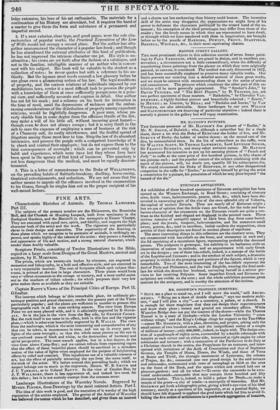ETRUSCAN ANTIQUITIES.
AN exhibition of three hundred specimens of Etruscan antiquities has been opened at the Western Exchange, in Bond Street; consisting of cinerary urns, fictile vases, lachrymatories, paterfe' idols, &c., which have been dis- covered in excavating part 9f the site of the once splendid city of Volterra, the capital of ancient Etruria. They are nearly all of Etruscan origin ; but we are of opinion that the fictile vases are Greek, for the rude and bar- barous character of the ornaments on the Etruscan vessels are quite a con- trast to the finished and elegant-art displayed. in the painted vases. These curious remains or antiquity appear to iiaié been dug from some burial- place; and the jewels, weapons, lachrymatories, and the numerous small ewers, paterw, &c., used in sacrifices, =chir confirm the snpposition, since articles of their description are found in ancient places of sepulture. The most interesting things in this collection are the cinerary urns. They are ornamented with bas-reliefs on the front, and ornaments at each end ; the lid consisting of a recumbent figure representing probably the deceased person. The sculpture is grotesque, figure, exhibits in its barbarous style an observation of nature in attitude, and an acquaintance with early Greek art in the designs ; one of these bas-reliefs, indeed, is a metope of the battle of the Lapithm and Centaurs ; and in the conduct of each subject, a dramatic propriety is visible in the grouping and positions of the figures, which is very remarkable. Two of the most interesting of the bas-reliefs represent the duel of Paris and Philoctetes, and the vain Emphile, wearing the fatal neck. lace for which she deserts her husband, surveying herself in a mirror pre- vious to her receiving Polynice. Some imperfect Greek and Etruscan in- scriptions are visible on the urns ; and the whole exhibition possesses great interest for the antiquary, and is worthy the attention of the curious.


















 Previous page
Previous page